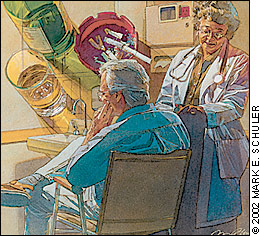
Am Fam Physician. 2002;65(3):361

On the cover of this issue of AFP, you'll see an illustration (above) showing a typical physician-patient encounter: An older man has consulted his family physician with a medical problem and has undergone a routine evaluation in the office setting. The physician has noted that he is a heavy smoker, with possible signs and symptoms of alcohol misuse; perhaps he's had a few abnormal laboratory results. The physician has now chosen an approach including one of the alcoholism screening questionnaires described in the cover article by Mary-Anne Enoch, M.D., M.R.C.G.P., and David Goldman, M.D., from the National Institute on Alcohol Abuse and Alcoholism, Bethesda, Md. (page 441).
The cover illustration by artist Mark E. Schuler, Prairie Village, Kan., depicts a common scenario for this complicated health problem. According to Drs. Enoch and Goldman, the incidence of alcoholism is twice as high in men as it is in women, and alcoholism continues to be a major health problem that eludes diagnosis. Although drinking often starts in adolescence, diagnosis of problem drinking and alcoholism may be missed over the long-term for a variety of reasons—and all too often patients are treated symptomatically for alcohol-related conditions without recognition of the underlying condition. Because the rate of alcoholism screening remains lower than 50 percent in health care settings, and because patients may withhold information for fear of stigmatization, the patient depicted on this issue's cover might have eluded diagnosis until serious medical complications arose.
The artist could have chosen to represent any number of other scenarios, however. According to Drs. Enoch and Goldman, the incidence of alcoholism has been increasing in women, and it's a disease that often has its onset during adolescence; approximately 40 percent of alcoholics develop their first symptoms between 15 and 19 years of age. Pregnant adolescents and adult women who drink, of course, place their infants at risk of fetal alcohol syndrome, and there's no patient population who can be considered free of risk for alcohol-related problems.
A related item in this issue's “Clinical Briefs” section highlights a recent statement released by the American Academy of Pediatrics (AAP) on alcohol use and abuse in children and adolescents. The statement, released by the AAP's Committee on Substance Abuse, reports an increasing percentage of children as young as nine years who have begun experimenting with alcohol. Approximately 9.5 million persons between the ages of 12 and 20 report having had at least one drink in the previous month; one half of those report binge drinking and 20 percent report heavy drinking. People who begin drinking before age 15 are four times more likely to have problems with alcoholism than those who begin drinking at age 21. The AAP statement includes a questionnaire specifically tailored to help physicians identify adolescents with alcohol abuse problems (see page 513).
Drs. Enoch and Goldman have provided a patient information handout to help physicians teach patients how to recognize when they may be having problems with alcohol (see page 449). The authors report that once a diagnosis of problem drinking or alcoholism is established, a treatment plan can be tailored to the situation. Problem drinking may respond to brief intervention based on motivational enhancement therapy, while treatment of alcoholism may involve a variety of psychosocial methods and pharmacotherapies.